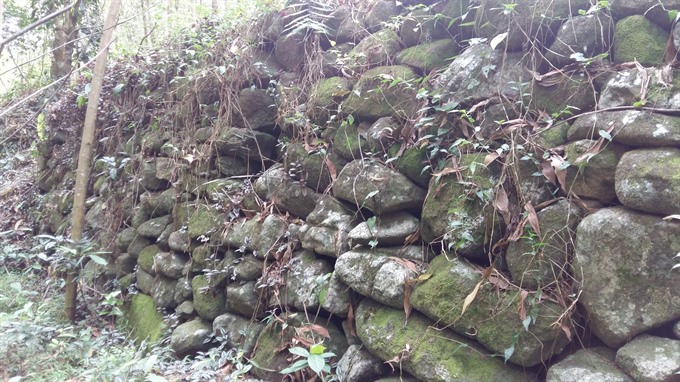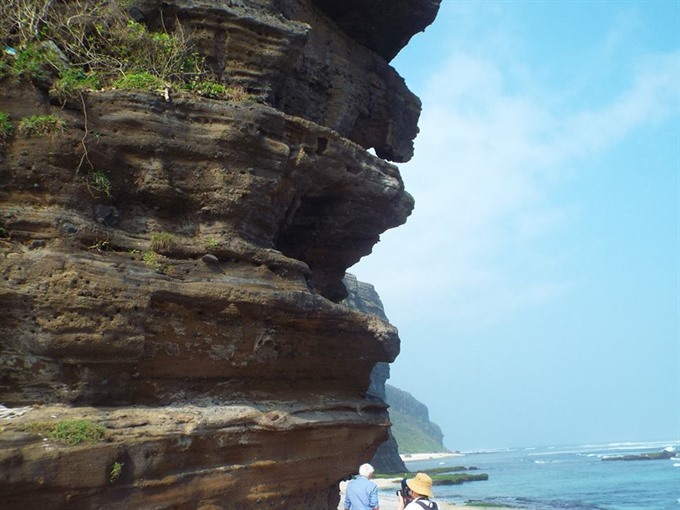Viet Nam News
by Bui Hoai Nam
LY SON ISLANDS — A giant, outdoor, natural museum. That’s what experts believe 2,000sq.km of land in Quang Ngai Province could soon become.
Proposals have been submitted to create a Global Geo-Park around Ly Son Island and large coastal and mountainous areas nearby.
Experts from the Viet Nam Institute of Geosciences and Mineral Resources along with international scientists hope the park plans will be approved by the UN cultural agency UNESCO.
The Director of the Viet Nam Institute of Geosciences and Mineral Resources, Tran Tan Van, said the Quang Ngai Geo-Park would cover a large area above and under the sea and land from Ly Son Island to the districts of Binh Son, Tu Nghia, Nghia Hanh, Mo Duc, Ba To, Son Ha, Tay Tra, and Sa Huynh.
He said the Geo-Park will include important values of history, culture and nature.
“Naturally, the province has an abundance of geological and culture heritages that are believed to have formed from the evolution of Paleo-proterozic Era.
“Current lagoon systems, rocks, sediment left from the era would promote the province as a giant outdoor museum,” Van said.
He said the area already boasts a number of historic landmarks, including ancient ports of Champa, Dai Viet (Great Viet) and Sa Huynh, and Son My vestige museum, Sa Huynh museum, and Truong Luy (Great Stone Wall) in Nghia Hanh District.
The geo-park will include 7,925ha of the Ly Son Marine Protected Area, 1,000ha Ca Dam Nature Reserve and another 39,000ha reserve in the west of Ba To District, he added.
In 2012, Vietnamese archaeologists salvaged a 700-year-old cargo vessel from the sea off Binh Chau Commune of Binh Son District, and the area will also be included in the Geo-Park boundary.
 |
| Heritage: An ancient stone wall in Nghia Hanh district. It was recognised as the National heritage site. — VNS Photo Cong Thanh |
Geological value
Setsuya Nakada, who is chair of the Advisory Committee of the Global Geo-Park Network, said the central province is really an abundant site of heritage values with a mixture of culture and geology diversity, and it would be possibly promoted as a geo-park site in the global geo-park network.
“I have visited Ly Son Island twice, and witnessed that the area of geo-park has been enlarged with rich values of culture and geology. At least five volcanoes and potentially active volcanoes occurred at central and south of Viet Nam in the Neogene-Quatenary (about 30 million years ago),” Nakada said.
He added those volcanic activities in Viet Nam are related to the subduction zone (Ring of Fire in Pacific region), and the formation of the South China Sea (called East Sea in Viet Nam).
Nakada said the volcanism in Ly Son Island is similar to those in the sea of Japan (in west of Japan), and Jeju Islands in South Korea.
Nakada, who is director general of centre for integrated volcano research, and national research institute for earth science and disaster resilience in Japan, warned that rubbish disposal has polluted the environment on Ly Son and the provincial government needs a strong management structure and action plan to protect and preserve the island.
“The boundary of the geo-park should be expanded to enrich the heritage value. The nature environment should be clean and rubbish littering must be stopped. However, it needs to reconsider the island’s capacity in hosting masses of tourists,” he said.
He said the story on the sunken ships off the coast of Binh Son District and other traditional stories should be told to add to the diversity of region.
“Successive research to understand the international significance of geology is requested. Then local people should understand the significances by their own words,” he said.
He said in preparation for UNESCO-recognition global geo-park submission in 18 months time, the local government should promote the management, protection, education and tourism on proposed sites.
 |
| Rock stars: A rock cliff in Ly Son Island. Basalt layers and rocks found in the Island were believed to be from volcanoes 30 million years ago. — Photo courtesy of Chu Manh Trinh |
Ngo Xuan Thanh, a researcher of volcano at the Ha Noi-based Mining and Geology College, said magma sample researches and field examination showed the volcano erupted to creat Quang Ngai somewhere betweeen 6.9 million and 9 million years ago.
“Samples of basalt and ancient rocks found in Ba Lang An and Ly Son Island were from the Miocene period. And eruptions in Ly Son and An Binh islet were different. Ash and basalt found in the Cau cave in Ly Son was a possible vestige of sea in the Flandrian when the sea level was six metres higher than now,” Thanh said.
Expert Pham Duc Luong said the Island of Ly Son witnessed at least three periods of volcanism with eruption areas from Ly Son to Phu Yen Province and Phu Quy Island in Binh Thuan Province.
Trinh Long, an expert in geology, said samples of metamorphic and igneous rocks found at Quang Ngai believed the geological formation was from 250 million to 460 million years ago.
He said at least three complexes of metamorphic and igneous rock and 12 magma complexes helped create some areas in Quang Ngai (Ba To and Tra Bong districts).
He said some sections of damaged walls of stone, which was found in Nghia Hanh District, were part of the 130km stone wall from Quang Ngai to Binh Dinh.
Doan Ngoc Khoi, from Sa Huynh Museum, said the Sa Huynh Culture (2,500 to 3,000 years ago) was almost undamaged in the province (tombs and other relics of Sa Huynh community).
Challenges
The booming of tourism and construction in Ly Son Island has seen as serious threats to the geo-park submission.
In early 2018, the province agreed a research and survey plan of developing luxury resorts and entertainment project by a property developer, FLC Group, on 1,243ha of Ly Son Island, An Binh Islet and the coast of Binh Chau Commune in Binh Son District.
As planned, the FLC Group project would need a land clearance plan on 184ha rice fields, 55ha protective forests, 86ha rural residential land, 502ha of farming land, and removal of a border guard station on 1ha.
It’s expected that more than 1,100 households will be relocated when resort construction begins.
The province agreed an advanced fund of VND550 billion (US$24.3 million) to compensate for land clearance, and open a passageway to the public beach every eight kilometres on the coast of Binh Chau Commune.
Nguyen Xuan Nam of the Viet Nam Institute of Geosciences and Mineral Resources said the proposal of developing resort project in Ly Son Island and on the coast of Binh Chau Commune would overlap to the global geo-park submission on the Islands.